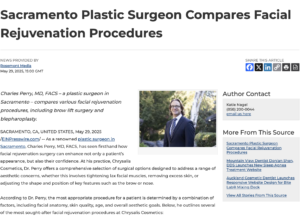We perform breast implant exchange, sometimes referred to as breast implant revision, at our well-equipped plastic surgery office. While breast implant revision surgery may be required for leaking breast implants or capsular contracture (hardening of the breast implant), it is more commonly done to change cup size.
Choosing the right size breast implant size and shape can be difficult, especially when considering how life circumstances and clothing styles change over time. For some the first choice of implant is too small while for others the augmentation creates breasts that become too large over time. Breast implant exchange is something to consider in either situation. In general, candidates for revisional surgery must be healthy and have realistic expectations.
What Makes Someone a Good Candidate For Breast Implant Revision Surgery?
Breast revision surgery might be right for you if you:
- Desire fuller breasts
- Desire smaller breasts
- Desire firmer breasts
- Desire softer breasts
Breast implant exchange can help you achieve the look you desire – whether it be a smaller leaner or a more voluptuous figure. In some cases your breast will grow as the skin loosens and stretches while in other situations they shrink as the breast itself becomes stretched and thinned over the implant and involution occurs. This can create an imbalance in your bodies’ aesthetic harmony, especially with weight loss or following pregnancy. At Chrysalis Cosmetics, we will help you make a great decision in regards to choosing a new size and style of implant.
Breast implant exchange is not recommended for:
- Individuals with untreated breast cancer or pre-malignant breast disorders
- Individuals with any type of active infection
- Women that are pregnant or nursing
- Individuals with a weakened or suppressed immune system
- Individuals suffering from certain medical conditions
- Individuals with reduced blood flow to the breasts
Health issues or medications that interfere with blood clotting or wound healing are problematic. Poor clotting can cause safety issues during surgery while poor wound healing can negatively affect the final outcome of surgery and cause discomfort. Reduced blood flow to the breast can result from prior surgery or radiation therapy and will need to be assessed on an individual basis by your qualified experienced plastic surgeon.
**Disclaimer: If you are a smoker, you MUST DISCONTINUE smoking a minimum of 4 weeks BEFORE & AFTER SURGERY. A nicotine test will be administered.**
The Procedure
The breast implant exchange procedure is often done using the previous incision and is usually performed in less than an hour. The old implant is exchanged for the newly sized. Occasionally a small lift or internal tightening is required in order to tighten or lift the breast to avoid sagging when going with a different size of breast implant. In some circumstances a drain will be placed for a few days.
Other reasons for breast implant revision surgery include capsular contracture or hardening of the breast implant capsule. The capsule can be removed and the implant exchanged at the same time or staged in some situations. Certainly you have many choices and options, which you will have the opportunity to discuss with our board-certified plastic surgeon, Dr. Charles Perry, during your initial consultation. It is important to make informed decisions when considering breast implant exchange especially when considering going to a smaller size. This requires more technical skill and presents more challenges than going to a larger breast implant.
Other options to consider are a staged procedure with removal of the current implant in lieu of exchange. This can then be followed by breast augmentation after a small convalescence allowing your tissues to relax and perhaps allowing you more time to consider which size to choose.
Things to Consider Before Undergoing Breast Augmentation Revision or Implant Exchange Surgery
Patients thinking of undergoing breast augmentation revision surgery should consider the following:
Symmetry
If your breasts differ in size or shape going into breast augmentation revision surgery, it is unlikely they will become completely symmetrical afterwards.
Long-Term Commitment
Breast augmentation revision with saline or silicone-filled implants is rarely a one-time surgery. Breast implants, regardless of type, are not considered to last a lifetime. Most likely, secondary or teritary surgery to replace or remove your breast implants will become necessary someday, or you may want to undergo breast lift as aging progresses.
Breast augmentation revision often causes permanent anatomical changes
Permanent anatomical changes resulting from surgery may be produced in the breasts. If the breast implants are removed, these aesthetic changes may become unacceptable.
Financial responsibilities
Breast augmentation revision, with or without breast lift, is done on a fee-for-service basis, and as such the procedure is not covered by health insurance. Your total surgical fee will include the cost of surgical supplies, anesthesia, laboratory tests, medications, surgery center charges, and possibly more. If you experience complications, you will probably incur additional expenses.
Are There Any Risks?
There are two categories of complications: those specifically related to breast implants, and more general surgical risks.
Risks Related to Breast Implants
Implant failure
Just like other medical devices, implants can break or leak. The advantage of saline implants is that in the event that it deflates, the body will safely absorb the salt water. Damaged implants cannot be fixed and must be replaced or removed during another surgical procedure. In addition, saline implants eventually wear out.
Capsular contracture
In some cases, scar tissue forms around the breast implant, then tightens. The result is a round, firm, and sometimes painful breast. Capsular contracture is impossible to predict and can occur anytime after surgery, though it is more common when implants are placed in front of the layer of chest muscle.
Implant extrusion/tissue necrosis
Infection or inadequate tissue coverage can result in the implant extruding through the skin. As the implant pushes through layers of skin, it becomes visible.
Skin rippling
While some wrinkling is normal following breast augmentation, sometimes implants wrinkle in a way that is visible and palpable. This problem is most pronounced in those with textured implants or thin breast tissue.
Change in breast sensation
Immediately after breast augmentation surgery, it’s common to experience some change in nipple sensation, similar to what happens after breast reduction. Most patients recover normal sensation in a few months. However, it’s possible to experience partial or permanent loss of skin and nipple sensation, and these changes can affect sexual response or breastfeeding ability.
Implant displacement
The implant may migrate or rotate away from its initial placement, which can cause discomfort or the distortion of the breast’s shape. To correct this problem, additional surgery may be needed.
Risks Related to Surgery in General
Bleeding during or after surgery
Postoperative bleeding may require emergency treatment to drain the blood. To prevent bleeding, avoid taking aspirin or any anti-inflammatory medications 10 days before surgery, as well as nonprescription herbs and dietary supplements.
Seroma (accumulation of fluid around the implant)
This may contribute to infection, capsular contracture, and other problems. Additional treatment may be required to drain the fluid.
Infection
Though rare, infection is a possibility. Infection may be treated with antibiotics, removal of the implant, or additional surgery.
Scarring
Though rare, it is possible that abnormal, unattractive scars will form, requiring additional corrective surgery.
Thrombosed veins
These veins, which resemble cords, may develop in the area of the breast but will resolve without intervention.
Pain
Pain is to be expected for a short period of time after breast augmentation surgery; however, in some cases it persists. Capsular contracture, sensory nerve entrapment, or injury to tissues can cause pain of various intensities and duration.
Unsatisfactory result
A variety of factors can lead to dissatisfaction with the results of breast augmentation surgery. These include asymmetry, nipple location, unanticipated breast shape or size, and unsatisfactory surgical scar location. In some cases, additional surgery may be needed or desired to remove the implants or improve your results.
Risks of breast implant exchange are similar to risks associated with breast augmentation and breast lift surgeries. However they are often greater in frequency and more severe as this is a secondary operation and the blood and nerve supply to the nipple has been altered creating a greater possibility for tissue loss, implant extrusion, injury to surrounding tissues, loss of sensation, rippling, infection, pain, bleeding, asymmetry, contracture, malposition, and re-operations.
Please contact Chrysalis Cosmetics today to learn more about breast implant revision surgery, or to schedule a consultation.


